The Nexus 6 Review
by Brandon Chester on November 12, 2014 1:00 PM ESTDisplay
The display is one of the most important aspects of a smartphone, as it is the part of the device that the user will interact with most. We've seen tremendous improvement in smartphone displays as they have become more and more commonplace within society. The first area of improvement was resolution, which made sense with text being a necessary part of essentially every smartphone application. As displays have gotten to the point where there is little benefit to further increasing pixel density, we have also seen a push for greater color accuracy and image rendition. On the Android side of the market, Google was one of the first companies to start taking color accuracy seriously, and the Nexus 7 and Nexus 5 had some of the best calibrated displays of all Android devices.
The Nexus 6 sports a 5.96" AMOLED display with a resolution of 2560x1440. Given Google's work to provide accurate color calibration on the Nexus 5, and the massive improvements that we've seen in the calibration of AMOLED displays over the course the past year, I was very excited to take a look at the display on the Nexus 6. However, as someone who typically uses the very well calibrated iPhone 6 and Nexus 5 in daily use, I immediately noticed that the Nexus 6 produced a punchier image than I was used to seeing in the applications I use frequently.
To take a look at the characteristics of the Nexus 6's display we turn to SpectraCal's CalMAN 5 software and an X-Rite i1 Pro 2 spectrophotometer for accurate measurements of the display's color. As always, we target the sRGB gamut which is currently the standard for photos on the web and video content.
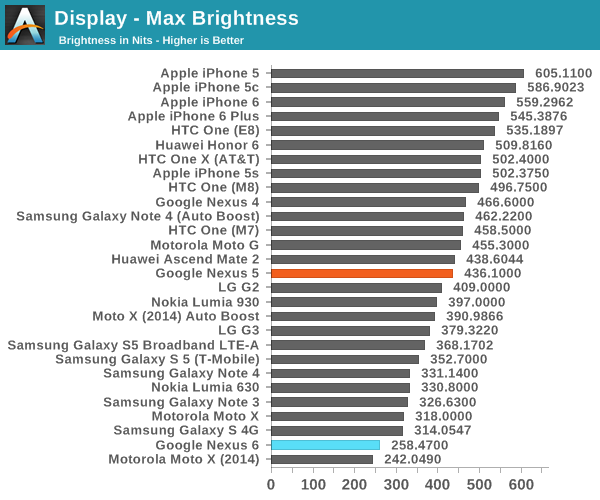
Contrast and black levels on the Nexus 6 are as incredible as ever. Brightness is definitely on the low side though. Testing was performed with both the manual brightness settings, and with Adaptive Brightness enabled and a bright LED aimed at the light sensor. In both cases the maximum brightness was the same, there's no higher brightness exposed when using the automatic brightness settings like there is for the Galaxy Note 4. What's interesting to note is that the brightness is similar to that of the 2014 Moto X, another recently released Motorola device that sports an AMOLED panel. However, even Moto X has an auto boost mode which pushes it up to 390nits. The overall similarity between the panel in the Moto X and the panel in the Nexus 6 persists throughout our other tests.
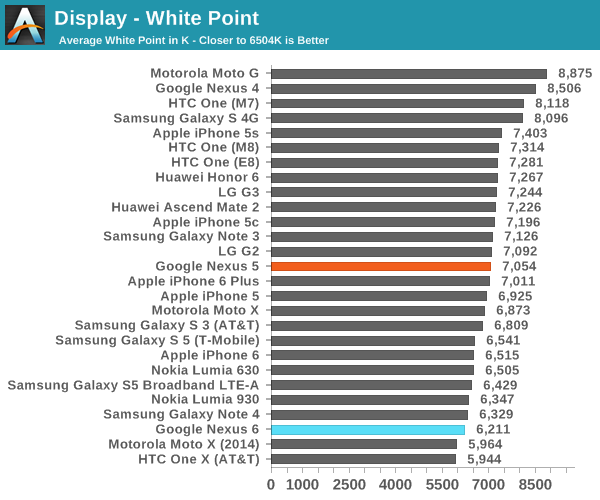
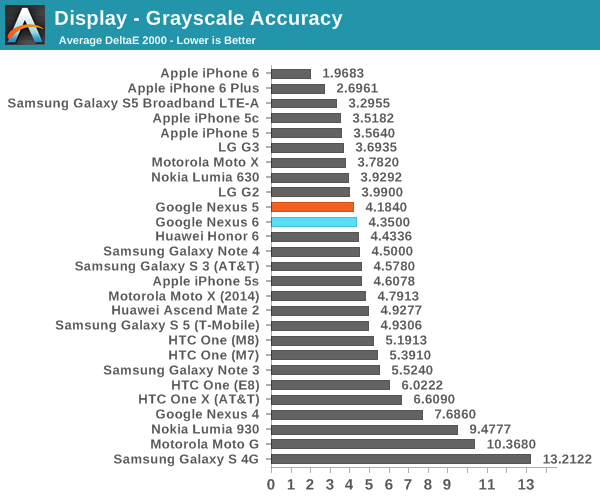
The Nexus 6 is slightly more red than our target for white point, though not to the extent of the 2014 Moto X. This contrasts with the IPS panel in the Nexus 5 which was too blue. In the greyscale we see that the luminance is comprised more of red and green than of blue. This translates to greyscale performance that is nothing exceptional, but not noticably worse than the Nexus 5, and still significantly improved compared to AMOLED panels from not long ago like the display in the Galaxy Note 3.
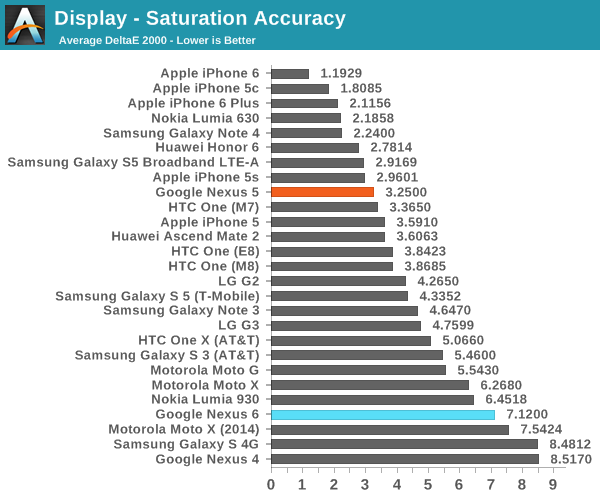
In our saturation sweep test, the Nexus 6 performs rather poorly. Unlike Samsung's phones which have several display modes with one of them targeting sRGB, the Nexus 6 has only one display setting and it significantly overshoots the sRGB gamut. This does a good job at creating showroom appeal but is not helpful in accurately displaying the color in photos and videos. This is especially disappointing because the Nexus 5 was well calibrated to sRGB and performed much better in this test.
The poor performance in the saturation sweep translates to equally poor performance on the ColorChecker test. The expanded gamut and saturation compression makes it effectively impossible for this display to render any sRGB content accurately. The greyscale performance helps to bring down the overall average, but the large errors with color mixtures prevent any sort of accurate image rendition.
I was highly disappointed by these results. Like I said earlier, we've seen great improvements in the quality of AMOLED displays as of late, and Google took color calibration very seriously with the Nexus 5. The Nexus 6 shows significant regression in color accuracy from the Nexus 5, and the maximum brightness is much lower. It should also be noted that despite its higher resolution, its larger size means that compared to the Nexus 5 the pixel density only increases 12% from 441 PPI to 493 PPI. The use of a PenTile RGBG subpixel layout also means that there is actually an overall decrease in subpixel density.
Overall, the Nexus 6 display is quite poor relative to the displays on other smartphones like the Galaxy Note 4, iPhone 6, and HTC One (M7). It's also a definite regression from the display on the Nexus 5, which is concerning given the fact that the Nexus 6 is $300 more expensive. It has been speculated that Motorola is unable to source the latest generation of panels from Samsung Display, which would explain why many of the panel characteristics are similar to previous generation AMOLED panels in the Note 3 and Galaxy S4. Although the efficiency of AMOLED displays when displaying black helps to reduce power usage with features like Ambient Display which wakes up the phone when notifications arrive or it is picked up, I don't believe it's worth the trade-off if it involves such heavy sacrifices in color accuracy and brightness.


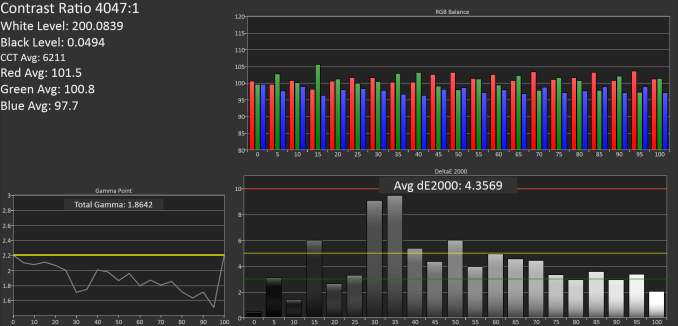
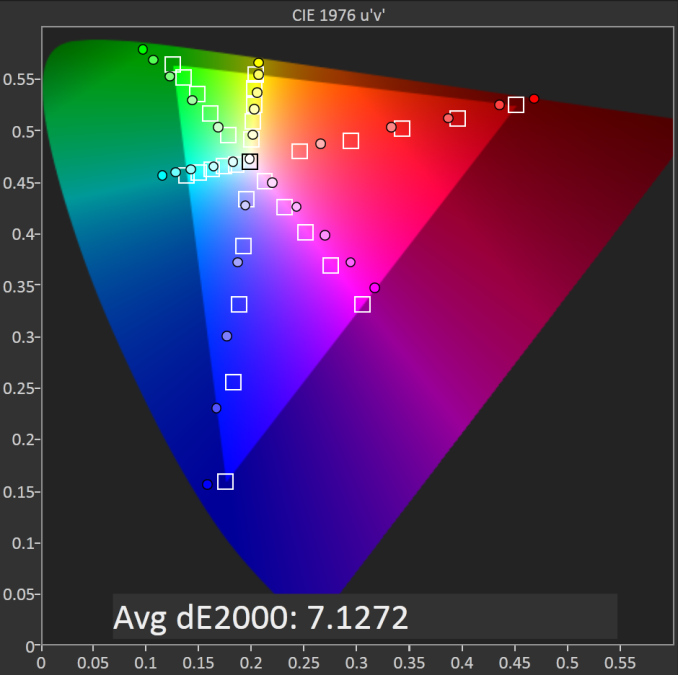









136 Comments
View All Comments
brentwgraham - Wednesday, November 12, 2014 - link
I pre-ordered the Nexus 6... I'm now wavering and considering either a Note 4 or an Xperia Z3...Good news is they bungled the launch so badly that mine hasn't even shipped yet.
Coup27 - Wednesday, November 12, 2014 - link
I also have a Z3 having come from an S4. The Z3 is awesome. I put the two side by side before selling my S4 and the display is much better on the Z3. The S4 had a green tint where as the Z3 seems to be accurate in colour reproduction and white point. The speakers produce a much better sound with the only negative being they aren't very loud. The design is great, but did take some getting used to. Finally, batter life is on another level. My S4 used to die after 2 days. With exactly the same usage I can easily hit 3 and still have some left.grayson_carr - Wednesday, November 12, 2014 - link
Well, guess I will stick with my Nexus 5 for now. The poor display brightness and calibration killed it for me. Not to mention the fact that he said the Nexus 5 feels faster on Lollipop. The size and price don't do the Nexus 6 any favors either. I love the Note 4 hardware, camera performance, accurate display calibration setting, and battery life, but after playing with one in store several times, I just don't think I can deal with how slow it felt and how many frames it dropped in pedestrian scrolling tasks.sqeaky_fartz - Wednesday, November 12, 2014 - link
Are the front facing speakers actually stereo, or is it like the 2nd gen Moto X in that regard?Brandon Chester - Wednesday, November 12, 2014 - link
Actually stereo.lostleaf - Friday, November 14, 2014 - link
Are you able to comment on the sound for the stereo speakers? I would like a comparison to the htc one m7 or m8.Spawne32 - Wednesday, November 12, 2014 - link
I can honestly say I wouldn't even remotely consider this phone an upgrade from the Nexus 5, which was a game changer for me in terms of sub $400 dollar smart phones. This is exactly what I expected with the switch from LG to motorola for the OEM for the nexus 6, a ridiculously high price tag for mediocre performance. It's a damn shame to see google stray away from providing a good quality phone at a reasonable price to some ridiculous hunk of crap at almost a $700 dollar price tag.tipoo - Wednesday, November 12, 2014 - link
I still think the performance degradation test makes more sense if you divide by the first cycle. The way it is, if a phone with performance of 100 drops 40%, and a phone with performance of 50 drops 10%, the first one will have dropped a lot more, but still show higher total performance in the end, when the test is about seeing how badly the device throttles.tipoo - Wednesday, November 12, 2014 - link
The system and web benchmarks show a regression from the nexus 5...Hmm.tipoo - Wednesday, November 12, 2014 - link
There are also some lag issues...I'm kind of relieved to see it has some lag issues, as that means Nvidias Denver isn't the culprit in the Nexus 9.